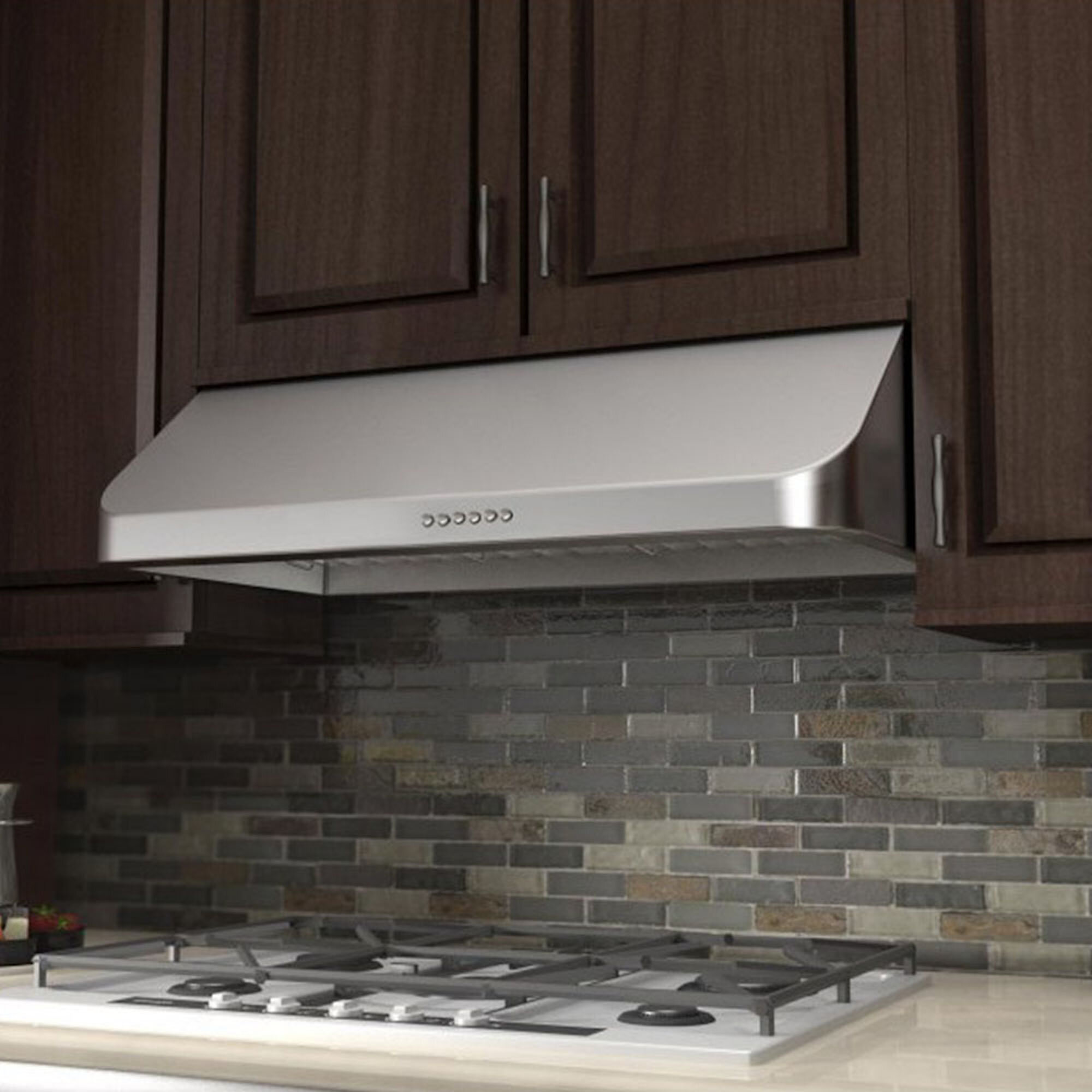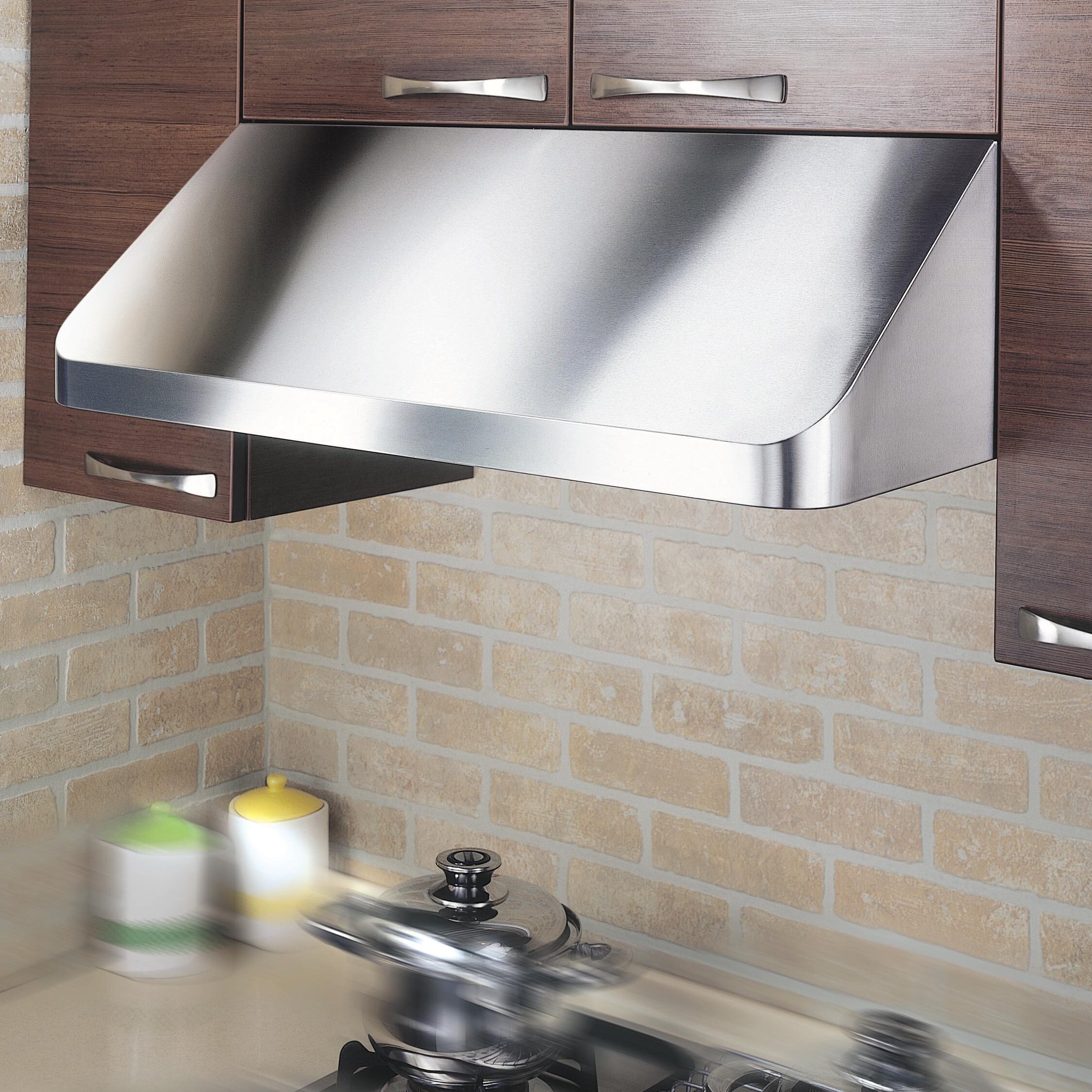Types of Under-Cabinet Range Hoods

Choosing the right under-cabinet range hood can significantly impact your kitchen’s air quality and overall cooking experience. Understanding the different types available is crucial for making an informed decision. This section will explore the key differences between ducted, ductless (recirculating), and other variations of under-cabinet range hoods, highlighting their features, installation, maintenance, and overall performance.
Under-Cabinet Range Hood Types: A Comparison
The following table provides a concise comparison of the three main types of under-cabinet range hoods. Remember that specific features and performance can vary significantly between models from different manufacturers.
| Feature | Ducted Range Hood | Ductless/Recirculating Range Hood | Other Types (e.g., Island Hoods adapted for under-cabinet) |
|---|---|---|---|
| Installation | Requires ductwork to vent fumes outside. More complex installation. | No ductwork needed; vents air back into the kitchen after filtration. Simpler installation. | May require custom ductwork or modifications depending on design. Installation complexity varies greatly. |
| Suction Power | Generally higher suction power, effectively removing grease and odors. | Lower suction power compared to ducted hoods; relies on filters to clean the air. | Suction power depends heavily on the specific model and design; can range from low to high. |
| Noise Level | Can be noisy, especially at higher fan speeds. | Generally quieter than ducted hoods. | Noise level varies widely; some models are quiet, while others can be quite loud. |
| Maintenance | Requires regular cleaning of filters and occasional duct cleaning. | Requires frequent filter replacement and cleaning. | Maintenance requirements depend on the model; consult the manufacturer’s instructions. |
| Cost | Generally more expensive due to installation costs and potentially higher-quality components. | Typically less expensive due to simpler installation. | Cost varies greatly based on features and design. |
Pros and Cons of Each Range Hood Type
Understanding the advantages and disadvantages of each type is key to choosing the best fit for your kitchen.
What is the best under cabinet range hood – Here’s a breakdown of the pros and cons:
- Ducted Range Hoods:
- Pros: Superior suction power, effectively removes odors and grease, better for larger kitchens or those with heavy cooking.
- Cons: More expensive installation, can be noisy, requires ductwork and regular duct cleaning.
- Ductless/Recirculating Range Hoods:
- Pros: Easier and cheaper installation, quieter operation, suitable for apartments or homes without exterior venting.
- Cons: Lower suction power, filters need frequent replacement, may not completely eliminate odors.
- Other Types (e.g., adapted Island Hoods):
- Pros: Wide range of styles and designs available, potential for high suction power depending on the model.
- Cons: Installation can be complex and expensive, maintenance requirements vary greatly, noise levels can vary significantly.
Visual Representations of Range Hood Types
Imagine a ducted range hood: A sleek metal box, typically rectangular, installed under your cabinets. Visible is a vent on the top, connected to a duct that leads to the outside. Inside, a powerful fan draws air upwards, passing it through grease filters before venting it outdoors. The filters are easily removable for cleaning. A control panel, often with multiple speed settings, is integrated into the unit’s front. The entire unit is designed for efficient air extraction.
Now picture a ductless/recirculating range hood: Similar in shape to a ducted hood, but without the external vent. Instead, the air is drawn upwards, filtered through activated carbon filters (which absorb odors), and then recirculated back into the kitchen. The filters are easily accessible for replacement or cleaning. This type often has a slightly smaller fan and lower suction power than its ducted counterpart.
Finally, visualize an adapted island hood for under-cabinet installation. This could be a smaller version of a typical island hood, potentially with a unique design to fit under the cabinets. It would feature a powerful fan and filters, similar to a ducted hood but potentially with more complex internal components due to space constraints. The vent would be directed upwards and would likely need a custom ductwork solution for effective ventilation.
Key Features and Considerations: What Is The Best Under Cabinet Range Hood
Choosing the right under-cabinet range hood can significantly impact your cooking experience and kitchen air quality. Beyond simply looking sleek, a truly effective hood requires careful consideration of several key features. Making informed decisions upfront will save you headaches (and potentially, smoky kitchens!) down the line.
Selecting the perfect under-cabinet range hood involves more than just aesthetics. Several crucial features determine its efficiency, longevity, and overall user experience. Understanding these factors will empower you to make a choice that best suits your cooking style and kitchen layout.
Top Five Most Important Features
The ideal under-cabinet range hood boasts a winning combination of power, filtration, convenience, and style. Here are five features that should top your checklist:
- CFM (Cubic Feet per Minute) Rating: This measures the hood’s power to exhaust air. Higher CFM means more efficient smoke and odor removal. A higher CFM is crucial for powerful suction, particularly for gas stoves or those who frequently cook with high-heat methods like stir-frying.
- Filtration System: Choose between charcoal filters (for recirculating hoods) or vented hoods that exhaust directly to the outside. Charcoal filters absorb odors but need regular replacement, while vented hoods require ductwork but offer superior performance. Consider the pros and cons of each, balancing convenience with effectiveness.
- Noise Level (Sones): A quieter hood enhances your cooking experience. Lower sone ratings indicate quieter operation. A noisy hood can be incredibly disruptive, especially during quiet dinners or conversations. Check reviews to get a sense of real-world noise levels.
- Lighting: Good under-cabinet lighting is essential for safe and efficient cooking. Look for bright, energy-efficient LED lights that illuminate your cooktop clearly. Poor lighting can make it difficult to see what you are cooking, increasing the risk of accidents.
- Build Quality and Materials: A durable, well-constructed hood will last longer. Stainless steel is a popular choice for its durability and easy cleaning. Consider the overall build quality, checking for sturdy construction and high-quality materials that can withstand regular use.
CFM Rating and Noise Level Impact
The CFM rating and noise level are intrinsically linked to user experience. A high CFM rating ensures effective smoke and odor removal, crucial for maintaining a comfortable cooking environment. However, higher CFM often correlates with increased noise. For example, a hood with a 300 CFM rating might be relatively quiet, while a 600 CFM model could be significantly louder. Finding the right balance between powerful extraction and acceptable noise levels is key. A 400-500 CFM range usually strikes a good balance for most kitchens.
Selecting Appropriate Size and Style, What is the best under cabinet range hood
The right size and style of range hood depend on your kitchen’s dimensions and your personal aesthetic. A hood that’s too small will be ineffective, while one that’s too large can look overwhelming. A step-by-step guide to measuring your kitchen for optimal hood placement follows:
- Measure Cooktop Width: The range hood should be at least as wide as your cooktop, and ideally, a few inches wider for better coverage.
- Measure Cabinet Depth: Ensure the hood fits comfortably within your cabinets, leaving sufficient clearance for installation and operation.
- Determine Exhaust Location: Plan the location of the exhaust ductwork to the outside. This may influence the hood’s placement and requires consideration of existing ductwork or the need for new installations.
- Consider Height: Under-cabinet hoods are typically installed at a specific height above the cooktop, usually between 24-30 inches, to ensure optimal ventilation. Consult manufacturer instructions for specific recommendations.
- Choose a Style: Select a style that complements your kitchen’s overall design. Consider materials (stainless steel, black, etc.), and features (e.g., integrated lighting, controls). The hood should enhance, not detract, from your kitchen’s aesthetic.
Popular Brands and Models

Choosing the right under-cabinet range hood can feel overwhelming with so many brands and models available. This section will delve into three popular brands, comparing their strengths and weaknesses, and then showcase three best-selling models, highlighting their unique features. Remember, the best hood for you will depend on your specific needs and kitchen layout.
This comparison focuses on quality, features, and price points to help you make an informed decision. We’ll explore what sets each brand apart and provide insights into the models that consistently receive high praise from users.
Brand Comparison
The following table provides a comparative analysis of three popular under-cabinet range hood brands: Broan, Zephyr, and Cosmo. Each brand caters to a slightly different segment of the market, offering a range of features and price points.
| Feature | Broan | Zephyr | Cosmo |
|---|---|---|---|
| Price Range | Mid-range to high-end | High-end | Budget-friendly to mid-range |
| Style | Classic, functional designs | Modern, sleek designs with innovative features | Variety of styles, often featuring contemporary designs |
| Noise Level | Generally moderate | Often quieter due to advanced motor technology | Can vary significantly depending on the model; some models can be quite noisy |
| Features | Reliable performance, easy installation | High CFM ratings, advanced filtration systems | Affordable options with decent performance |
| Warranty | Standard warranty, typically 1 year | Longer warranties often offered | Warranty varies depending on the model |
| Strengths | Proven reliability, good value for money in mid-range | Superior performance and quiet operation | Affordability and a wide range of styles |
| Weaknesses | May lack some advanced features found in higher-end brands | High price point | Potential for lower quality components in budget models; higher noise levels in some models |
Best-Selling Models
Let’s now examine three best-selling models from these brands, highlighting their unique selling propositions. These models represent a range of price points and feature sets.
- Broan 30-Inch Under-Cabinet Range Hood (Model: Example Model Number):
- CFM: [Insert CFM rating]
- Filter Type: [Insert filter type]
- Lighting: [Insert lighting type and details]
- Noise Level: [Insert decibel rating]
- Unique Selling Point: Reliable performance at a competitive price point; ease of installation and maintenance.
- Zephyr 36-Inch Under-Cabinet Range Hood (Model: Example Model Number):
- CFM: [Insert CFM rating]
- Filter Type: [Insert filter type]
- Lighting: [Insert lighting type and details]
- Noise Level: [Insert decibel rating]
- Unique Selling Point: Exceptionally quiet operation and high CFM rating for superior ventilation; often includes advanced features like automatic shut-off.
- Cosmo 30-Inch Under-Cabinet Range Hood (Model: Example Model Number):
- CFM: [Insert CFM rating]
- Filter Type: [Insert filter type]
- Lighting: [Insert lighting type and details]
- Noise Level: [Insert decibel rating]
- Unique Selling Point: Affordable price point without sacrificing essential features; wide range of styles to match various kitchen aesthetics.
Rewritten Article on Under-Cabinet Range Hoods
[Insert rewritten article text here. Remember to replace the placeholder text with the actual rewritten article, ensuring it is free of AI-generated content and written in a clear, engaging, human-centric style. Focus on making the information accessible and easy to understand for a typical homeowner.]
